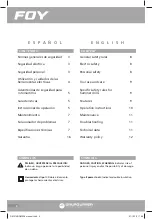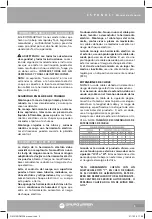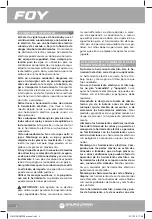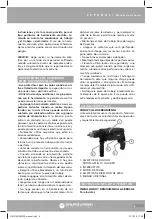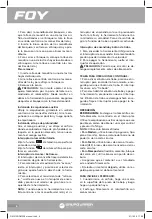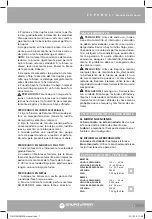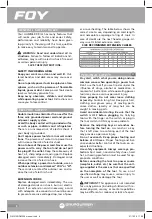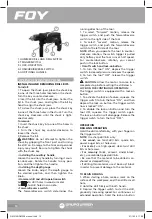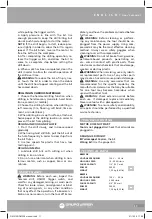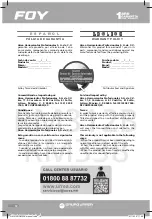
11
E N G L I S H •
User’s manual
while pulling the trigger switch.
4. Apply pressure in line with the bit. Use
enough pressure to keep the drill biting, but
do not push hard enough to stall the motor.
NOTE: If the drill begins to stall, reduce pres-
sure slightly in order to allow the bit to regain
speed. If the bit binds, reverse the motor to
free the bit from the workpiece.
5. After completing the drilling operation, re-
lease the trigger switch, and allow the bit to
come to a complete stop before setting the
drill down.
6. When work has been completed, clean the
drill in order to allow for smooth operation of
the drill over time.
WARNING: To reduce the risk of injury, nev-
er touch the bit in order to clean the debris
until the drill has stopped rotating and the bit
has cooled down.
DRILLING IN VARIOUS MATERIALS
1. Choose the hammer-drilling function when
drilling in hard masonry (concrete, hard brick,
stone, cement, or marble).
2. Choose the drilling function when drilling in
soft masonry (tile, flooring, soft brick, lime ce-
ment, or cinder block),.
3. When drilling in a smooth surface, attach ad-
hesive paper at the drilling location in order to
prevent the bit from gliding.
DRILLING IN WOOD AND PLASTIC
1. Start the drill slowly, and increase speed
gradually.
2. When using twist drill bits, pull the bit out of
the hole frequently in order to clear chips from
the bit flutes.
3. Use low speeds for plastic that has a low
melting point.
DRILLING IN METAL
1. Lubricate drill bits with cutting oil when
drilling in iron or steel.
2. Do not use a lubricant when drilling in non-
ferrous metals, such as copper, brass or alu-
minium.
MAINTENANCE
WARNING: Before each use, inspect the
hammer drill, ON/OFF trigger switch, and
cord for any damaged, missing, or worn parts.
Check for loose screws, misalignment or bind-
ing of moving parts, or any other condition
that may affect the operation. If abnormal vi-
bration or noise occurs, turn the tool off imme-
diately, and have the problem corrected before
further use.
WARNING: Before cleaning or perform-
ing any maintenance, the tool should be un-
plugged from the power supply. Using com-
pressed air may be the most effective cleaning
method. Always wear safety goggles when
cleaning tools with compressed air.
WARNING: Do not let brake fluid, gasoline,
petroleum-based products, penetrating oil,
etc., come in contact with plastic parts. These
substances contain chemicals that can damage,
weaken or destroy plastic.
WARNING: When servicing, use only identi-
cal replacement parts. Use of any other parts
may create a hazard or cause product damage.
WARNING: Use only accessories that are
recommended for the specific model by the
manufacturer. Accessories that may be suitable
for one tool may become hazardous when
used with another tool.
WARNING: Check extension cords before
each use. If damaged, replace immediately.
Never use tool with a damaged cord.
WARNING: To ensure safety and reliability,
all repairs should be performed by a qualified
service technician.
TROUBLESHOOTING
MOTOR DOES NOT START
Tools is not plugged in: Check that all cords are
plugged in.
DRILLING IS DIFFICULT
Bit’s damaged: Replace the bit.
Wrong bit: Use the proper bit.
TECHNICAL DATA
VOLTAGE-FREQUENCY
NO LOAD SPEED
CHUCK CAPACITY
POWER
WEIGHT
120 V ~ 60 Hz
(0 - 3 000) r/min
1/2" (12,7 mm)
500 W
1,55 kg
(3,41lb)
VOLTAGE-FREQUENCY
NO LOAD SPEED
CHUCK CAPACITY
POWER
WEIGHT
120 V ~ 60 Hz
3 000 r/min
3/8" (10 mm)
500 W
1,50 kg (3,30 lb)
RM312B
RM338
RM312B-RM338 manual.indd 11
01/12/16 17:09


